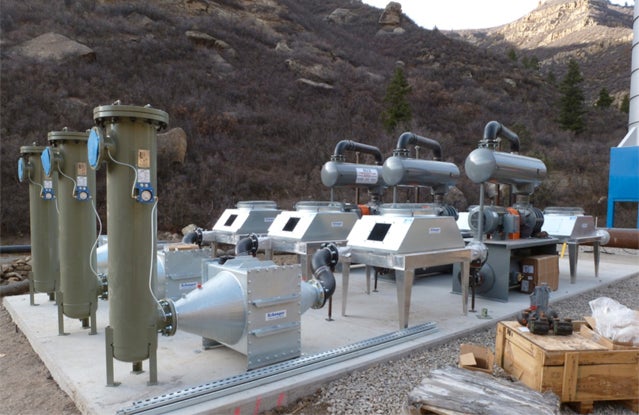
Before it was at the vanguard of North American luxury ski resorts, Aspen, Colorado, was a mining town. Now, has made a $5.4 million investment in a coal mine—a mine owned, no less, by billionaire climate change denier Bill Koch. But the investment is actually for a clean energy project. Really.
Here's how it works: The money was put into a system that captures methane emissions that are vented from the Elk Creek mine in Somerset, Colorado, and then uses this gas to generate electricity, which is fed into the grid. This not only prevents the methane—a greenhouse gas 20 times more harmful that carbon dioxide—from entering the atmosphere, but it will use this byproduct of coal mining to eliminate three times the carbon pollution that the Aspen ski resort creates each year.
The project kicked off today with a press conference at the mine site.
Aspen Skiing Company (ASC) is among the most outspoken and proactive ski resorts looking to mitigate the effects of climate change, which could essentially destroy the snow-sports industry. While it has made investments in wind, solar, and even small hydro power (to the tune of about $1.5 million), none of those projects will come close to the impact of the methane-to-energy project, says Auden Schendler, ASC's vice president of sustainability, both in terms of cost and impact. It will produce as much energy as ASC—all of its resorts, hotels, and other properties—uses in a year.
“This all came out of our interest in generating a lot of clean power, as a ski resort. We've been looking for something really big, and this was by far the best bang for the buck,” says Schendler. This project, which cost around $6 million total, will generate enough electricity from the captured methane to eliminate 96,465 tons of CO2 equivalent every year. That's like removing 13,151 cars from the road. To get an equal amount of carbon reduction from a solar energy project, Aspen would have had to spend around $400 million, says Randy Udall, an independent energy analyst who helped develop the project.
What's more, the Elk Creek project is pulling energy out of methane, which Udall compares to “carbon dioxide on steroids,” and which would otherwise be wasted and end up in the atmosphere. (Coal mines vent methane gas because it's very dangerous—an explosion in a mine southwest of Carbondale killed 15 men in 1981.)
While the energy accounting is quite attractive, this is far from a marketing-friendly project. Despite the major financial commitment ASC has made, there are no pretty turbines to photograph, for one thing. And due to the distance of the mine from the ski resort, those methane-produced electrons won't be used to turn any bull-wheels at Aspen or Snowmass. They're being fed into the grid and will be consumed elsewhere. But Schendler says the significant carbon reductions are more important.
“We could have bought Renewable Energy Credits [carbon offsets] and claimed we had zeroed out our energy use. The EPA would have said good job and we'd get good press, but we wouldn't have really done anything,” he says. “So instead, we're putting clean energy on the grid.”
STRANGE BEDFELLOWS
This is an unusual energy project with an even more unusual collection of stakeholders. Elk Creek Mine has entered into the project because it saw a means of capitalizing on a waste product, but without the funding from ASC, it would not have happened. Nor would it have happened were it not for , a former oil-and-gas developer and a Coloradan who had long been trying to develop a coal mine methane energy project. The final vital party is , a utility provider based in Glenwood Springs.
Elk Creek Mine is owned by , an energy company owned by Koch. He and his brothers are major political contributors of, typically, far-right candidates.
“The interesting part of the story is the weirdness of it,” says Schendler. “You have a ski resort concerned about climate change partnering with a coal mine that does not cop to climate change at all. I was in the meeting with them, and I said, 'It's such a great project and that it's so good for the environment.' One person held up his hand and said he disagreed that this is good for the environment. He said, 'We're resource guys, and we don’t want to waste this resource.'”
ASC, on the other hand, didn't spend the money just to create a clean energy project. All of the stakeholders have entered into a partnership and will receive a share of the revenue of the electricity sold—since ASC fronted the lion's share of the project costs, it will receive the biggest share of revenue. ASC estimates it will see a 12 percent return annually.
By purchasing the power from the mine, Holy Cross will reduce the carbon intensity of their product by 10 percent while increasing their annual wholesale power cost by just one percent, says Udall. So it's a win for the utility as well.
This is the first project west of Mississippi to turn coal-mine methane into electricity, and the hope is that more similar projects will be installed. “This is something local environmental groups and the EPA have been talking about and looking at for at least 10 years,” says Udall. “These deep mines in this part of the country are also some of the gassiest” so the energy potential and the greenhouse gas reduction potential are both very high.
Coal mining is the fourth largest source of human-related methane emissions, according to the EPA. Landfills and agriculture account for larger methane emissions, and methane-to-energy projects have also been installed in those industries.
—Mary Catherine O'Connor